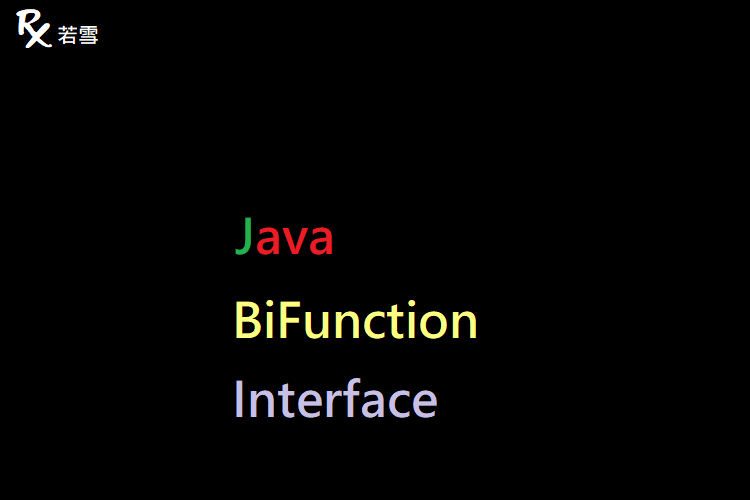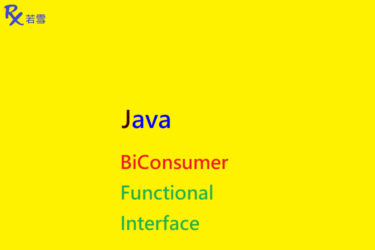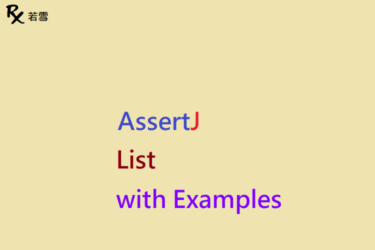Table of Contents
ToggleJava BiFunction Interface
常用於物件轉換或數字運算,也可當作其他方法的傳入參數或是引用其他方法為實例, BiFunction Interface 介紹 Map 中的 compute 、 merge 、 replaceAll 等方法,了解 BiFunction 的不同操作和方法,本篇增加了範例,並透過單元測試來驗證產出結果。
@FunctionalInterface
public interface BiFunction<T, U, R> {
R apply(T t, U u);
}
檔案目錄
./
+- src
+- test
| +- org
| +- ruoxue
| +- java_147
| +- functional
| +- bifunction
| +- BiFunctionInterfaceTest.java
單元測試
BiFunction Interface Java 提供 Map 中的 compute 、 merge 、 replaceAll 等方法操作 BiFunction Interface 。
Food
Function Interface Java 建立 Food 類別,覆寫 equals 、 hashCode ,定義屬性和方法,用來建立一個物件。
@NoArgsConstructor
@Getter
@Setter
@Builder
public static class Food {
private String name;
private double quantity;
private int type;
public Food(String name, double quantity, int type) {
this.name = name;
this.quantity = quantity;
this.type = type;
}
public String toString() {
ToStringBuilder builder = new ToStringBuilder(this, ToStringStyle.JSON_STYLE);
builder.appendSuper(super.toString());
builder.append("name", name);
builder.append("quantity", quantity);
builder.append("type", type);
return builder.toString();
}
public boolean equals(Object object) {
if (!(object instanceof Food)) {
return false;
}
if (this == object) {
return true;
}
Food other = (Food) object;
return new EqualsBuilder().append(getName(), other.getName()).isEquals();
}
public int hashCode() {
return new HashCodeBuilder().append(getName()).toHashCode();
}
}Map_compute
BiFunction Interface Java 建立 BiFunction ,建立一個 HashMap ,增加三個元素,計算符合條件的新值。
@Test
public void Map_compute() {
Integer expected = 7;
Map<String, Integer> map = new HashMap<String, Integer>();
map.put("Bacon", 1);
map.put("Ham", 2);
map.put("Pork", 3);
String key = "Bacon";
BiFunction<String, Integer, Integer> addition = (s, i) -> s.length() + i + 1;
Integer result = map.compute(key, addition);
System.out.println(result);
System.out.println(map);
assertEquals(expected, result);
Map<Food, Integer> foodMap = new HashMap<Food, Integer>();
foodMap.put(new Food("Bacon", 1, 1), 1);
foodMap.put(new Food("Ham", 2, 1), 2);
foodMap.put(new Food("Pork", 3, 1), 3);
BiFunction<Food, Integer, Integer> multiply = (o, i) -> (int) (o.name.length() + o.quantity * 2);
Food foodKey = new Food("Bacon", 1, 1);
Integer foodResult = foodMap.compute(foodKey, multiply);
System.out.println(foodResult);
assertEquals(expected, foodResult);
System.out.println(foodMap);
}7
{Ham=2, Bacon=7, Pork=3}
7
{{"name":"Bacon","quantity":1.0,"type":1}=7, {"name":"Ham","quantity":2.0,"type":1}=2, {"name":"Pork","quantity":3.0,"type":1}=3}
Map_computeIfPresent
BiFunction Interface Java 建立 BiFunction ,建立一個 HashMap ,內有三個元素,計算已存在的 Key 新值, Java BiFunction Interface Example 提供範例參考。
@Test
public void Map_computeIfPresent() {
Integer expected = 2;
Map<String, Integer> map = new HashMap<String, Integer>();
map.put("Bacon", 1);
map.put("Ham", 2);
map.put("Pork", 3);
String key = "Bacon";
BiFunction<String, Integer, Integer> addition = (s, i) -> i + 1;
Integer result = map.computeIfPresent(key, addition);
System.out.println(result);
assertEquals(expected, result);
key = "Bread";
result = map.computeIfPresent(key, addition);
System.out.println(result);
assertNull(result);
System.out.println(map);
Map<Food, Integer> foodMap = new HashMap<Food, Integer>();
foodMap.put(new Food("Bacon", 1, 1), 1);
foodMap.put(new Food("Ham", 2, 1), 2);
foodMap.put(new Food("Pork", 3, 1), 3);
BiFunction<Food, Integer, Integer> multiply = (o, i) -> (int) o.quantity * 2;
Food foodKey = new Food("Bacon", 1, 1);
Integer foodResult = foodMap.computeIfPresent(foodKey, multiply);
System.out.println(foodResult);
assertEquals(expected, foodResult);
foodKey = new Food("Bread", 1, 1);
foodResult = foodMap.computeIfPresent(foodKey, multiply);
System.out.println(foodResult);
assertNull(foodResult);
System.out.println(foodMap);
}2
null
{Ham=2, Bacon=2, Pork=3}
2
null
{{"name":"Bacon","quantity":1.0,"type":1}=2, {"name":"Ham","quantity":2.0,"type":1}=2, {"name":"Pork","quantity":3.0,"type":1}=3}
Map_merge
BiFunction Interface in Java 建立 BiFunction ,建立一個 HashMap ,內有三個元素,指定 key 值,合併 value 舊值與新值, Java BiFunction Interface Example 提供範例參考。
@Test
public void Map_merge() {
Integer expected = 11;
Map<String, Integer> map = new HashMap<String, Integer>();
map.put("Bacon", 1);
map.put("Ham", 2);
map.put("Pork", 3);
String key = "Bacon";
BiFunction<Integer, Integer, Integer> addition = (i, i2) -> i + i2;
Integer result = map.merge(key, 10, addition);
System.out.println(result);
assertEquals(expected, result);
key = "Bread";
result = map.merge(key, 11, addition);
System.out.println(result);
assertEquals(expected, result);
System.out.println(map);
Map<Food, Integer> foodMap = new HashMap<Food, Integer>();
foodMap.put(new Food("Bacon", 1, 1), 1);
foodMap.put(new Food("Ham", 2, 1), 2);
foodMap.put(new Food("Pork", 3, 1), 3);
BiFunction<Integer, Integer, Integer> multiply = (i, i2) -> (int) i * i2;
Food foodKey = new Food("Bacon", 1, 1);
Integer foodResult = foodMap.merge(foodKey, 11, multiply);
System.out.println(foodMap);
assertEquals(expected, foodResult);
}11
11
{Ham=2, Bacon=11, Pork=3, Bread=11}
{{"name":"Bacon","quantity":1.0,"type":1}=11, {"name":"Ham","quantity":2.0,"type":1}=2, {"name":"Pork","quantity":3.0,"type":1}=3}
Map_replaceAll
BiFunction Interface in Java 建立 BiFunction ,建立一個 HashMap ,內有三個元素,取代所有元素的值, Java BiFunction Interface Example 提供範例參考。
@Test
public void Map_replaceAll() {
Map<String, Integer> map = new HashMap<String, Integer>();
map.put("Bacon", 1);
map.put("Ham", 2);
map.put("Pork", 3);
BiFunction<String, Integer, Integer> length = (s, i) -> s.length() + i;
map.replaceAll(length);
System.out.println(map);
Map<Food, Integer> foodMap = new HashMap<Food, Integer>();
foodMap.put(new Food("Bacon", 1, 1), 1);
foodMap.put(new Food("Ham", 2, 1), 2);
foodMap.put(new Food("Pork", 3, 1), 3);
BiFunction<Food, Integer, Integer> multiply = (o, i) -> (int) o.name.length() * i;
foodMap.replaceAll(multiply);
System.out.println(foodMap);
}{Ham=5, Bacon=6, Pork=7}
{{"name":"Bacon","quantity":1.0,"type":1}=5, {"name":"Ham","quantity":2.0,"type":1}=6, {"name":"Pork","quantity":3.0,"type":1}=12}
BiFunctionInterfaceTest.java
BiFunction Interface in Java 新增單元測試,驗證 Java BiFunction Interface Example 是否符合預期。
package org.ruoxue.java_147.functional.bifunction;
import static org.junit.Assert.*;
import java.util.HashMap;
import java.util.Map;
import java.util.function.BiFunction;
import org.apache.commons.lang3.builder.EqualsBuilder;
import org.apache.commons.lang3.builder.HashCodeBuilder;
import org.apache.commons.lang3.builder.ToStringBuilder;
import org.apache.commons.lang3.builder.ToStringStyle;
import org.junit.Test;
import lombok.Builder;
import lombok.Getter;
import lombok.NoArgsConstructor;
import lombok.Setter;
public class BiFunctionInterfaceTest {
@NoArgsConstructor
@Getter
@Setter
@Builder
public static class Food {
private String name;
private double quantity;
private int type;
public Food(String name, double quantity, int type) {
this.name = name;
this.quantity = quantity;
this.type = type;
}
public String toString() {
ToStringBuilder builder = new ToStringBuilder(this, ToStringStyle.JSON_STYLE);
builder.appendSuper(super.toString());
builder.append("name", name);
builder.append("quantity", quantity);
builder.append("type", type);
return builder.toString();
}
public boolean equals(Object object) {
if (!(object instanceof Food)) {
return false;
}
if (this == object) {
return true;
}
Food other = (Food) object;
return new EqualsBuilder().append(getName(), other.getName()).isEquals();
}
public int hashCode() {
return new HashCodeBuilder().append(getName()).toHashCode();
}
}
@Test
public void Map_compute() {
Integer expected = 7;
Map<String, Integer> map = new HashMap<String, Integer>();
map.put("Bacon", 1);
map.put("Ham", 2);
map.put("Pork", 3);
String key = "Bacon";
BiFunction<String, Integer, Integer> addition = (s, i) -> s.length() + i + 1;
Integer result = map.compute(key, addition);
System.out.println(result);
System.out.println(map);
assertEquals(expected, result);
Map<Food, Integer> foodMap = new HashMap<Food, Integer>();
foodMap.put(new Food("Bacon", 1, 1), 1);
foodMap.put(new Food("Ham", 2, 1), 2);
foodMap.put(new Food("Pork", 3, 1), 3);
BiFunction<Food, Integer, Integer> multiply = (o, i) -> (int) (o.name.length() + o.quantity * 2);
Food foodKey = new Food("Bacon", 1, 1);
Integer foodResult = foodMap.compute(foodKey, multiply);
System.out.println(foodResult);
assertEquals(expected, foodResult);
System.out.println(foodMap);
}
@Test
public void Map_computeIfPresent() {
Integer expected = 2;
Map<String, Integer> map = new HashMap<String, Integer>();
map.put("Bacon", 1);
map.put("Ham", 2);
map.put("Pork", 3);
String key = "Bacon";
BiFunction<String, Integer, Integer> addition = (s, i) -> i + 1;
Integer result = map.computeIfPresent(key, addition);
System.out.println(result);
assertEquals(expected, result);
key = "Bread";
result = map.computeIfPresent(key, addition);
System.out.println(result);
assertNull(result);
System.out.println(map);
Map<Food, Integer> foodMap = new HashMap<Food, Integer>();
foodMap.put(new Food("Bacon", 1, 1), 1);
foodMap.put(new Food("Ham", 2, 1), 2);
foodMap.put(new Food("Pork", 3, 1), 3);
BiFunction<Food, Integer, Integer> multiply = (o, i) -> (int) o.quantity * 2;
Food foodKey = new Food("Bacon", 1, 1);
Integer foodResult = foodMap.computeIfPresent(foodKey, multiply);
System.out.println(foodResult);
assertEquals(expected, foodResult);
foodKey = new Food("Bread", 1, 1);
foodResult = foodMap.computeIfPresent(foodKey, multiply);
System.out.println(foodResult);
assertNull(foodResult);
System.out.println(foodMap);
}
@Test
public void Map_merge() {
Integer expected = 11;
Map<String, Integer> map = new HashMap<String, Integer>();
map.put("Bacon", 1);
map.put("Ham", 2);
map.put("Pork", 3);
String key = "Bacon";
BiFunction<Integer, Integer, Integer> addition = (i, i2) -> i + i2;
Integer result = map.merge(key, 10, addition);
System.out.println(result);
assertEquals(expected, result);
key = "Bread";
result = map.merge(key, 11, addition);
System.out.println(result);
assertEquals(expected, result);
System.out.println(map);
Map<Food, Integer> foodMap = new HashMap<Food, Integer>();
foodMap.put(new Food("Bacon", 1, 1), 1);
foodMap.put(new Food("Ham", 2, 1), 2);
foodMap.put(new Food("Pork", 3, 1), 3);
BiFunction<Integer, Integer, Integer> multiply = (i, i2) -> (int) i * i2;
Food foodKey = new Food("Bacon", 1, 1);
Integer foodResult = foodMap.merge(foodKey, 11, multiply);
System.out.println(foodMap);
assertEquals(expected, foodResult);
}
@Test
public void Map_replaceAll() {
Map<String, Integer> map = new HashMap<String, Integer>();
map.put("Bacon", 1);
map.put("Ham", 2);
map.put("Pork", 3);
BiFunction<String, Integer, Integer> length = (s, i) -> s.length() + i;
map.replaceAll(length);
System.out.println(map);
Map<Food, Integer> foodMap = new HashMap<Food, Integer>();
foodMap.put(new Food("Bacon", 1, 1), 1);
foodMap.put(new Food("Ham", 2, 1), 2);
foodMap.put(new Food("Pork", 3, 1), 3);
BiFunction<Food, Integer, Integer> multiply = (o, i) -> (int) o.name.length() * i;
foodMap.replaceAll(multiply);
System.out.println(foodMap);
}
}心得分享
Java BiFunction Interface Example 使用 Lambda 表達式能讓程式碼更加簡潔與直接,取代傳統實作接口的方法,減少了很多程式碼,大幅提高可讀性, BiFunction Interface in Java 提供了幾種 BiFunction 常見方法的操作範例,熟悉這些方法的操作,能夠提高開發效率,節省維護上的成本。




